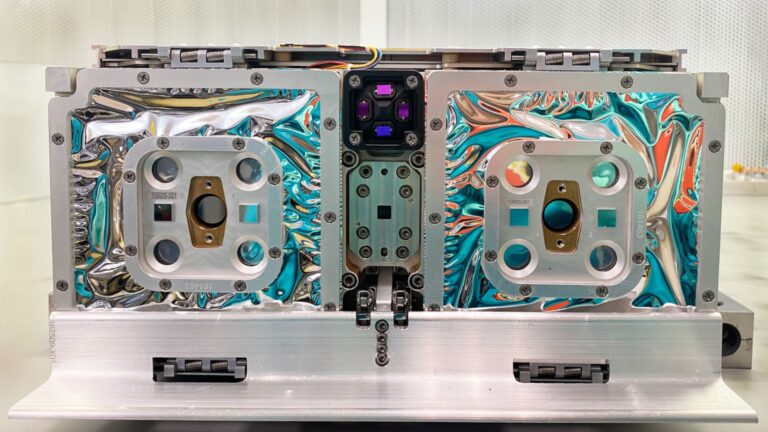
Since July 2022, a miniature satellite about the size of a shoebox has been orbiting Earth and monitoring how much solar energy reaches the atmosphere. Now, scientists are finalizing their analysis of the first five months of measurements it gathered while in orbit.
The Sun is by far the largest source of energy to Earth, dwarfing the energy generated by Earth’s core, and it plays a major role in global climate. Precise and accurate measurement of how much solar energy is absorbed by Earth— Total Solar Irradiance (TSI)—is crucial to our understanding of Earth’s climate system.
The CubeSat, called the Compact Total Irradiance Monitor-Flight Demonstration, or CTIM-FD, is on a one-year mission to develop and test new technologies for measuring TSI.
CTIM-FD was designed and built by the Laboratory for Atmospheric and Space Physics (LASP) at the University of Colorado Boulder and the National Institute of Standards and Technology (NIST).
A key part of this mission is to directly compare the measurements of CTIM against its larger counterparts to demonstrate that it can perform measurements just as precisely and accurately.
“The CTIM mission plays a key role in the future of solar irradiance measurements. The CubeSat platform allows us to go from the first idea to on-orbit demonstration much faster than traditional space technology, allowing us to quick demonstrate its viability as well as learn how we’d improve the instrument design for future missions,” said David Harber, principal investigator (PI) of the CTIM-FD mission and instrument engineer at LASP.
Isolating exactly how much energy is coming from the Sun helps climate scientists tease apart the various natural and human components of Earth’s energy budget. In the latest Earth Science Decadal Survey, TSI, which is measured in watts per square meter, was designated one of the “Most Important” measurements for Earth scientists to make.
Extending a crucial 40-year climate record
Since 1978, scientists have used a variety of space-based instruments to measure TSI. CTIM is a smaller, lighter version of earlier LASP-built Total Irradiance Monitors (TIMs) that flew on various missions. These include: the Solar Radiation and Climate Experiment (SORCE) which lasted from 2003 to 2020; the Total Solar Irradiance Calibration Transfer Experiment, which operated from 2013 to 2019; and the Total and Spectral Solar Irradiance Sensor 1 (TSIS-1), which has been on the International Space Station since 2017.
These and other instruments have maintained a continuous record of total solar irradiance for more than 40 years, providing climate scientists with an invaluable data set. LASP has provided this measurement for the last 20 years. Maintaining this unbroken record of TSI data is critical for preparing future generations of scientists to understand and mitigate the effects of climate change.
Smaller, lighter, cheaper
But these larger, heavier instruments are more expensive to build and launch. CTIM was made smaller and lighter using a number of innovations. Foremost were the new silicon bolometers developed jointly with the NIST Boulder Sources and Detectors group led by John Lehman and fabricated at NIST by Nathan Tomlin.
The silicon detectors absorb optical light using carbon nanotubes. The nanotubes were grown vertically, forming a very dark surface that absorbs sunlight and heats up. The detector also has a thermistor made of a material whose resistance is dependent upon its temperature, which provides a very accurate measure of radiant heat.
“The heart of the instrument is the detector, and so shrinking the detectors is the key step in shrinking the instrument,” Harber said. “Traditional detectors use larger cavities to absorb light but carbon nanotubes allow us to absorb as much as a cavity with a flat surface.”
CTIM was launched on a Virgin Orbit Launcher One rocket as a ride-share on the U.S. Space Force’s STP-Sat 28A mission and was funded through the InVEST program in NASA’s Earth Science Technology Office. LASP’s CubeSat mission operations and data systems teams are providing the commanding, downlink, data capture, and data analysis for CTIM-FD operations through ground stations at LASP in Boulder.
The CTIM on-orbit measurements will be presented in January 2023 at the American Meteorological Society’s annual meeting in Denver.
LASP is a research institute at the University of Colorado Boulder that is on a mission to transform human understanding of the cosmos by pioneering new technologies and approaches to space science. Founded a decade before NASA, LASP is the only academic research institute in the world to have sent instruments to every planet in our solar system.
Written by Sara Pratt, LASP Senior Communications Specialist



